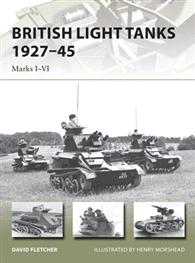This book recounts the development and service of a range of light tanks used by the British Army from the late 1920s until World War II. It is the usual efficient package we have come to expect from David Fletcher filled with plenty of detail and considered observations and, as ever, it is refreshing because the author admits there are some things he does not know the answer to and declines to bullshit us. Good.
In my trade publications such as this tend to be called bookazines these days, where there is too much for a magazine article but not enough for a full-scale book. Interestingly, David Fletcher tells us in his introduction that there are enough stories about these tanks to fill a larger book, but here we must be content with fifty pages of otherwise incisive history, superb archive photography and the likeable artwork of Henry Morshead.
How much hindsight does it take to see that these light tanks were going to be utterly hopeless in the face of far superior armour pitted against them during the first two years of the war? We can see the attraction they held in terms of cost and the number available at a time when the British cavalry arm went through essential but painful mechanisation. I can almost see the notion that a small tank took on the form of a horse in some minds and it must be that the experience gained using them will have had some value to the men who went on to bigger and (sometimes) better vehicles.
Obviously there is a hardwired futility about these machines it is impossible to escape and story of how one tank crew stuffed smelly socks into the holes made by a German shell that passed clean through the turret is a stark reminder of the fate of the men who were not so lucky in the course of their onerous duties.
It’s an aside but thinking about it brings to mind The Hill, a fictional tale where the Sean Connery character is a busted Squadron Sergeant Major of the Royal Tank Regiment sent down for thumping an officer who ordered a suicidal attack in tanks like these. Drama aside it important to note the factual history of these little tanks and acknowledge that in the Mk VI the British had a vehicle that served in almost every theatre until superseded.
Yes, we can consign these tanks to the dustbin of armoured warfare history, but I wouldn’t be too smug about it if I were you. As said, hindsight is a wonderful thing, but when the war started these tanks were available in numbers and the horrible reality is the old adage something is better than nothing applies, however weak that appears.
David Fletcher is correct that they are interesting vehicles and points to some examples in museums. I remember the hubbub when one was restored for Jacques Littlefield and I was really peed off I missed the chance to photograph it before it left Britain for California.As with all the other 1930s armour, these vehicles have an innocence about them that was about to be swept away and their appeal often outweighs their merits.
At fifty pages this neat little book has far more bang for it’s buck than the machine guns the hapless little tanks mounted. It is a superb way to learn about the history of armoured warfare and like many families, even tanks had runts in the litter that escaped being drowned at birth.
Reviewed by Mark Barnes for War History Online.
BRITISH LIGHT TANKS 1927-45
Marks I – VI
By David Fletcher
New Vanguard 217
Osprey Publishing
ISBN: 978 1 78200 377 9
